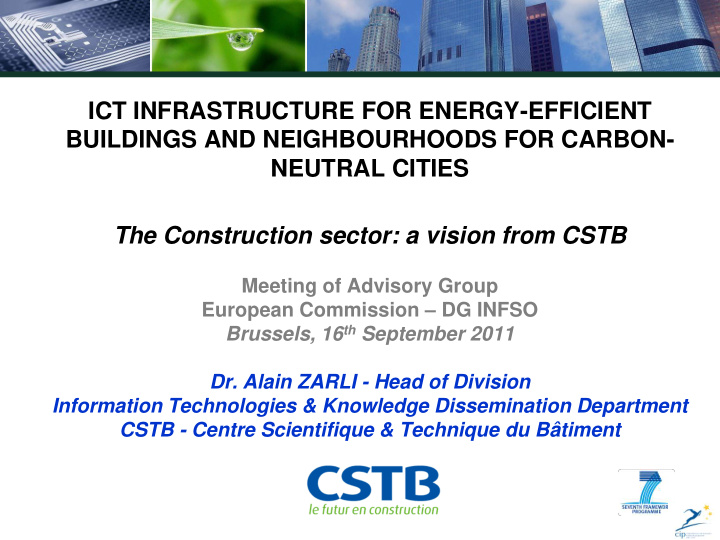



ICT INFRASTRUCTURE FOR ENERGY-EFFICIENT BUILDINGS AND NEIGHBOURHOODS FOR CARBON- NEUTRAL CITIES The Construction sector: a vision from CSTB Meeting of Advisory Group European Commission – DG INFSO Brussels, 16 th September 2011 Dr. Alain ZARLI - Head of Division Information Technologies & Knowledge Dissemination Department CSTB - Centre Scientifique & Technique du Bâtiment
EE neighbourhoods, districts & cities – do we have some common definitions ? Object – what is exactly the considered spatial dimension? Neighbourhood: scale at level of a group of adjacent buildings; District: integrates a set of connex buildings, public spaces, roads, vehicles, undergrounds, and networks (in a broad sense) + inhabitants, users (e.g. commuters), and administrators / managers; City: a network of connected districts – with potential interfaces... Potential factors to be considered Spatio-temporal synergies inferred by a usage mix (including mutualisation of energy production and recovery); Physical interaction – direct (e.g. umbrage common wall) or indirect (through any kind of network) – inter-buildings; Energetic expenses related to public spaces (e.g. urban lighting); Energetic retro-actions district / environment; Mobility. Objectives – from an ICT point of view : To produce ICT tools: gathering & analysing information and supporting decision-making (e.g. through simulation) specificaly for the district / city scales contributing to « decarbonate » the balance energy / greenhouse gases with respect to: operating the district; transforming the district. Alain ZARLI – CSTB – September 2011
From eeBMS to eeNMS and eeCMS New role in innovative distributed energy production with new associated business models Renewable energy management Distribution optimisation of local energy production Storage of energy/electricity, to deal with erasing consumption peaks Optimisation of energy balance (demand vs supply) Management of coordination of the energetic system Ensuring appropriate integration with smart energy grids - including securing the provision at any time of the energy ... in a systemic approach & according to various contexts (energy production mode, user profiling, safety,…). Quantification of deposit of decentralised (decarbonated) energy production Decentralised/distributed energy production & management – leading to local resources & energy generation (preferably only renewable, or mixing renewable & fossil-based) Taking into account multi-constraints sets (regulations, urban planning…) Identifying relevant management modes Alain ZARLI – CSTB – September 2011
From current experimentations... Schematic illustration of the operationnal side of the Nice Grid project ( on the French Riviera ) Alain ZARLI – CSTB – September 2011 REF: http://www.capenergies.fr/index.php?2011/07/07/618-capenergies-en-pole-position-sur-les-smart-grids
...towards a potential holistic vision Infrastructure / interoperability – including data security Modeling & simulating complex systems Interfaces (to users) / Dashboards Models of USAGE Decision making-support ICT Models of TRANSITION Live large-scale experimentations – with Data / information standardisation front runners cities / urban areas as potential (“in - vivo”) living labs - Organisation (urban patterns) - Management & Costs - Renovation / Evolution TRANSPORT BUILDING Water Heat networks Waste management Renewable Smart Grids Hydrogen Electricity Production of electricity Alain ZARLI – CSTB – September 2011
A 3-fold view... Or a 3-pillars model of reference? eeD&C / Energy Evaluate the energy-related interest in developping EPMS: which system for which EPMS : district - measure / simulate / capitalise info. Energy Production Define optimised management of EPMS algorithms Mutualised System Technical support to service deployment: identify the services, considering building constraint Evaluate the environmental impact of EPMS: kWh indicator, computing, observation. Conveying & storing Evaluate the economic impact of EPMS: kWh- digital “smart data / events” observer indicator over networks . eeD&C / ICT eeD&C / Services Analysis of expectations re. ICT tools for network managers & users Definition of architectures (hardware & Modelling systems & users (behaviours, software) for the development of usage) / Business-View models atop the energetic services Making objects Urban digital mock-up allowing New algorithms for systemic “smart” over the interoperability of tools dedicated to the design or exploitation of networks – management of EE districts & cities network/grid (ICT (predictive mode, agent, optimal control) Contribution to standardisation works empowerment) Digital modelling to assess energetic Digital modelling of the Building-network interface (exchanged information) – link value of new EE services developed in Micro-grids with intelligent metering Definition of energetic dashboards to ICT tools for design & optimal achieve benchmarking studies – management of networked systems based “Smartly” integrating indicators suitable to usage / on global optimisation techniques (GAs, users neuronal networksetc.) and or global processing data sensitivity algorithms Definition of a method to according to compute/visualise the energetic charge of Definition & prototyping of interfaces / indentified patterns a district – based on dashboards for visualising, designing or building/usage/system data managing information (for users, / global objectives designers, managers…) Alain ZARLI – CSTB – September 2011
The right questions... ? Methodological questions “from -global-to- detail” OR “from -detail-to- global” approach? Starting from “conceptual” scenarios OR building -up from live experimentations? Defining trends from exemplary projects? … Technical questions What are the observation methods? What are the adaptation strategies? What is the impact of energy storage on intelligent networks? … Organisational questions How to create a critical mass of research & innovation at EU level in the areas of ICT-based technologies / services for energy efficiency in neighbourhoods & cities? How to ensure the usage value of technical solutions, for instance through large-scale pilots, user panels, education of citizens? How to achieve systemic evaluation (KPI-based) of complex systems? … Alain ZARLI – CSTB – September 2011
Thank you for your attention alain.zarli@cstb.fr
Recommend
More recommend